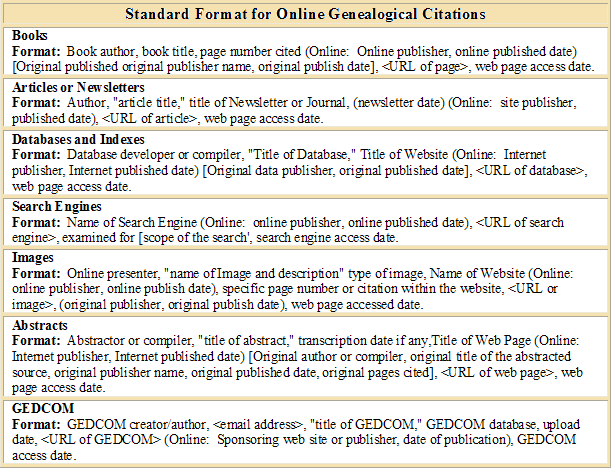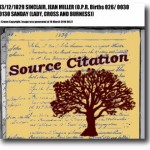Lesson 1 Articles
How to Cite Family Tree Information Sources
March 2, 2012 by ramona
Filed under Articles, Genealogy Standards & Guidelines, Introduction to Genealogy, Latest News, Lesson 1 Articles
As a family tree enthusiast, you are probably aware that your genealogical information comes from multiple places such as government agencies, Old Parish Records, monumental inscriptions, online genealogy sites, books and newspapers. No matter where you found the information about your ancestors it is simply good practice to cite your sources. The basics of citing a source are simple.
Citing a Genealogy Source Consists of Naming:
- Who created the source (publisher, historical society, government agency)
- What the source was titled (John O’ Groat’s Journal)
- When the information was created (copyright or year of publication)
- Where the information was created (State, County, and/or name of publisher)
- How you found it (name of repository or archive)
- Why it is a good source (primary, secondary or tertiary source)
Citing sources is particularly important if you plan to publish your family tree to the internet and it helps all of us involved in family tree research to sort out the reliable information from assumptions and guesswork.
Citing Sources for the Genealogy Beginner Citing sources can also be time consuming and confusing if you are not familiar with how to cite properly a source of genealogical information. For starters, here are some general helps and guidelines to citing a source.
Genealogy Citation Guidelines:
- <angle brackets> are for internet addresses <https://www.genealogybeginner.com/>
- [brackets] are for descriptive information
- Information about publishers should be in
- (parentheses)
Always cite exactly what you have found along with where you found it If you have doubts either leave it out or note is as a supposition.
For example in the case of a Monumental Inscription:
PETER SINCLAIR, CATHERINE CALDER Erected By Peter Sinclair In Memory Of His Wife Catherine Calder Who Died At Greentoft, 21st March 1905, Aged 72 Years. Also Peter Sinclair, Born At Cleat, Sanday, 12th June 1830, Died At Greentoft, Eday, 3rd January 1917
Citation:
Orkney Family History Society , “Orkney Graveyard Search for: Sinclair in Eday & Pharay, Old Kirkyard, St Marys, Eday Orkney” (Orkney Family History Society ) [Ray Millar ] <http://www.orkneyfhs.co.uk/mis/minscriptions.php?opt=gyard&gref=151&surname=Sinclair> Report date: 04/03/12
note: Eday, Orkney, Scotland: Eday Old Kirkyard, Orkney, Scotland Plot: 329
It also helps to become familiar with the abbreviations used in citing your family tree information sources along with the standard formats used. Standard
Abbreviations for Genealogical Citations

Standard Format for Online Genealogical Citations

Citing your sources will give you the confidence to publish your family tree knowing that all of your hard work is beyond reproach. You can learn more about the importance of citing your family tree research and genealogy best practices in Genealogy Beginner’s Lesson 1: The Big Five Genealogy standards and guidelines: what you need to know first
Image Credit: Ramona Hartley
Genealogy Standards: You Need to Know Now
December 17, 2011 by Sherri
Filed under Articles, Genealogy Standards & Guidelines, Introduction to Genealogy, Latest News, Lesson 1 Articles
 You have found some intriguing information on an ancestor that has you very excited.
You have found some intriguing information on an ancestor that has you very excited.
It is a significant event
Gives dates and places
May even promise to break through a brick wall
What it does not have is a proper source citation. Do you believe it or not?
I share the following story with you to demonstrate why learning to use and strictly follow the Genealogy Standards and Guidelines may be the most important lesson you learn.
Here is why Genealogybeginner.com’s Lesson 1 – The Big Five Genealogy standards and guidelines is so important!
Genealogy Believe it or Not
While working on collecting documented evidence to use in a biography for an ancestor. I ran across a web page that claimed to place my ancestor in North America 15 years earlier than previously thought. It also connected him with a notable historic person.
There are two reasons why this information is both extremely exciting and misleadingly dangerous.
Family Tree Excitement
- The source had the BDM information correct
- Another tie to this notable person and my ancestor has been well documented in government sources.
Ancestors in Danger
These two facts make the information I found plausible. However, I have not run across this particular event in any known primary or secondary source.
So, although excited to find this reference, the first thing I did was look for a source citation for the event. Sadly there was none listed, in fact there were no source citations listed for anything. Far too often this is the case and far too often misleading information is assumed to be fact by trusting, inexperienced ancestor hunters.
A Caution for the Genealogy Beginner
1. Indexes, databases and published family trees
Indexes, databases and published genealogical works are wonderful research helps when used correctly. They are not EVER to be considered sources under any circumstances. Indexed information, although associated with a primary source record, is not the record itself.
2. If you can not document the source it is simply genealogy fiction
When recording your information provide a complete and full citation of your sources. Without this information all the work you have done is simply fiction.
Everything you need to know about genealogy standards and guidelines is available to you right here at genealogybeginner.com.
Subscribe today for your need to know lesson on Genealogy Standards & Guidelines
Image credit: haleyb412 via Photobucket

